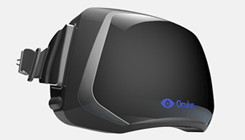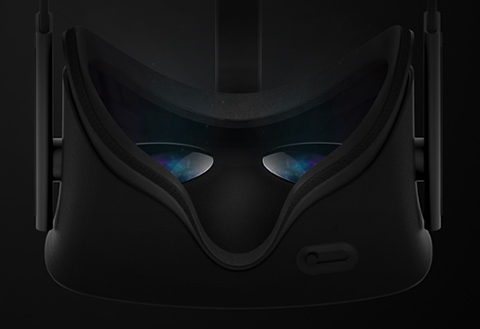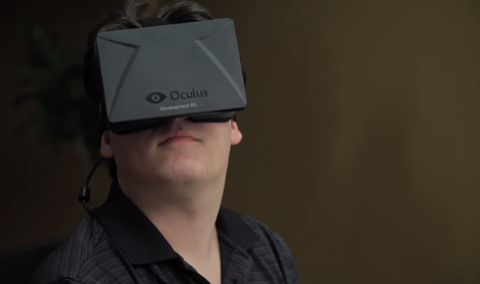The term “game changer” gets thrown about a lot these days, but if there is one device to which it can be correctly applied, it's the Oculus Rift. The Kickstarter-funded virtual reality headset single-handedly revived interest in immersive gaming experiences. Could it inject some much-needed life into flagging PC sales, too?  For PC manufacturers, these are interesting times. Consoles and portable devices have been eating into sales. While PCs have always enjoyed a performance edge, consoles have been getting better and better. The next generation consoles may not pack a comparable processing punch, but they should provide a comparable gaming experience. That, and the fact that console manufacturers can recoup hardware losses through software sales, makes today's PC industry a very tough business. Recent comments and developments would suggest that the Rift is going to be a PC-oriented device. Oculus VR is gearing its headset for the PC, rather than the Xbox One or PS4. While aligning the Rift to the PC community might seem counter-intuitive, it actually makes a lot of sense. It ties the Rift to a much larger development community and targets users who should be more inclined to part with $300 for a new peripheral. The purchase is a little easier to justify for someone who has already shelled out $1,500 on a mid-range gaming rig than for someone who spent $500 on a console. There may be more gamers than ever, but everyone places differing levels of importance on gaming as a pastime. Logically, the first people to target are the connoisseurs.
For PC manufacturers, these are interesting times. Consoles and portable devices have been eating into sales. While PCs have always enjoyed a performance edge, consoles have been getting better and better. The next generation consoles may not pack a comparable processing punch, but they should provide a comparable gaming experience. That, and the fact that console manufacturers can recoup hardware losses through software sales, makes today's PC industry a very tough business. Recent comments and developments would suggest that the Rift is going to be a PC-oriented device. Oculus VR is gearing its headset for the PC, rather than the Xbox One or PS4. While aligning the Rift to the PC community might seem counter-intuitive, it actually makes a lot of sense. It ties the Rift to a much larger development community and targets users who should be more inclined to part with $300 for a new peripheral. The purchase is a little easier to justify for someone who has already shelled out $1,500 on a mid-range gaming rig than for someone who spent $500 on a console. There may be more gamers than ever, but everyone places differing levels of importance on gaming as a pastime. Logically, the first people to target are the connoisseurs.
The Relationship Will Be Complicated
While PC sales have been hurting for some time, there are still a lot of them around. For most people, CPUs are as powerful as they need to be – the biggest payoffs can be found by upgrading the GPU. For a long time CPU demands were the engine behind PC sales, but our requirements aren't growing the way that they once were. This needs to be taken into consideration with regard to the Rift, as most potential buyers will already have a machine that is up-to-spec to handle its requirements. That being said, if the stars align and people start spending more time immersed in the VR experience, there's a good chance that they'll be more inclined to upgrade their equipment. When playing a game, I love nothing more than being able to max out all or most of the settings. The Oculus Rift could help to steer the PC industry in the right direction, but it needs to find its own market first.
Independent Development is Everything
The Rift is a truly special device for a number of reasons: First, it was crowd-funded. Second, it was funded at a time when VR wasn't a mainstream technology. Third, the company seemed to come out of nowhere. Big technology was asleep at the wheel, but it won't be for long. The Rift could well be to VR what the Hero was to action cams. But first it needs to get into the hands of as many developers, and onto the heads of as many consumers, as possible. As with any gaming/computer-related technology, the key to uptake will be content – more specifically, it will be the free content that really makes the Rift. Big title games are important, but updating game libraries to include Rift-compatible titles costs money. Add that to the price of the headset itself and things start to get expensive. Granted, people can acquire such titles slowly, but then the Rift becomes something that is used occasionally – a curiosity or novelty that spends most of its time in a drawer. To make it a must-have device, Oculus VR needs to turbocharge content production by encouraging as much amateur development as possible. The company’s launch of the VR Jam, which pumps $50,000 into development of Rift-compatible programs, is a step in the right direction. With a projected price of around $300, the headset isn't exactly expensive, but it costs enough to make some potential users think twice. People will be much more inclined to part with their hard-earned money if they have access to a decent volume of free content. Make no mistake, major commercial titles will have just as big a part to play, but what will get the Rift into the homes of early adopters will be amateur productions: tours of Tuscany, guillotine simulators, etc. It's the experimenters who will drive the technology into new directions and, dare I say it, lay the groundwork for the more polished commercial projects that follow. A solid library of free content will give people opportunities to explore, and that makes for a greater level of perceived satisfaction. In turn, that will greatly benefit word-of-mouth. Encouraging the indie community will help bring in the early adopters, the first piece of the puzzle, if you will. However, making the Rift mainstream will take a lot more work. If the Rift is to offer any sort of lifeline to PC gaming, it will have to become more than mainstream -- it will have become ordinary. Early adopters are influencers and will help drive sales, but again that will only go so far. To extend beyond a relative handful of technology enthusiasts, the solution will have to be cheap.
It Has to Be Cheap
One of the ideas that Oculus VR is exploring, according to CEO Brendan Iribe, is subsidizing the device, or even giving it away. While that sounds farfetched, there are a number of ways a subsidized model could work – even a model that was subsidized to the point of being zero-cost. The loss-leader concept is nothing new. It has worked well for the likes of Microsoft and Sony with their current generation consoles, and the same approach seems to have been taken regarding the pricing structure of their next generation counterparts. Also, Kindle prices fall well ahead of those of their components. However, selling a product cheaply and giving it away are altogether two different things. Oculus Rift could be sold for less than it costs to make and losses could be recouped from software sales. The trouble with that model is that Oculus VR is not in the content production business. This could be overcome with a royalty or licensing fee for commercial material – but that would become unworkable as competing products start hitting the market. While not free, a subscription-based model would allow people to get the Rift home for little to no money, which would be more attractive to some users. Losses due to delinquent payments could be recouped through profits made through long-term subscribers. As a consumer, I would prefer to pay upfront, but there are plenty of people who think differently. Another alternative would be to partner with PC or console manufacturers and include the Rift as part of a package. A free or cheap Rift could help to boost sales. In the case of console manufacturers, that would have a flow-on effect when it comes to game sales – a roundabout way to possibly sell more. It almost seems workable, but there seem to be a few too many “ifs”. Where it makes a lot of sense is with distribution platforms – more specifically, Steam. The company has an enormous user-base, a great content delivery infrastructure and a management ideology that seems to be more or less in-line with that of Oculus VR. More importantly, the always-on Steam platform would give them the cold, hard metrics that would let them figure out exactly what would work. They would not just know who buys what and for how much, they'd know who is playing what, and how long and how often they are playing – valuable data when it comes to figuring out how much money to lose on the device and how much to pull back in from the games. It would seem to be the perfect match for the oft talked about but never seen Steam console, which will almost certainly be a small form-factor PC. Steam would give the Rift a fantastic platform and an affordable Steam console packaged with a Rift could put more people in front of PCs, but would that really help the industry as a whole? In the case of the Steam user-base, it is very much a case of preaching to the converted. Any impact in PC sales will have to flow-on from there and any impact would be hard to judge. Given the recent comments from Oculus VR regarding the PC orientation, I wouldn't be surprised if Steam enters the picture sometime in the not too distant future.
It Has to Inspire
Perhaps the most important thing that the Oculus Rift can do for the PC industry right now is to drive innovation and imitation. The consumer VR market is potentially huge but, at present, totally untapped. It could be hard for a young company to meet the potential demand, and nothing kills interest like a long waiting list. A few competing products on the market could help ease some of the demand and spur development of next-generation headset technology. At the end of the day, it's unrealistic to expect a single device to reinvigorate an industry that some consider moribund. The power of mobile devices is increasing and our demands are changing. The PC, as we knew it, has become much less important. It still has a place, but that place is morphing. Virtual reality technology has the potential to make PCs a much more attractive option. They lack the constraints of consoles in terms of interoperability. They are upgradeable and expandable, and thus arguably better-suited to bringing VR into the home. As the technology extends beyond the headset to other areas of the virtual experience, it becomes something that is a little more makeshift, a little more do-it-yourself and a little more closely aligned to the traditional PC gaming culture. We will not see anywhere near the same level of independent development with closed console environments. The creative explosion -- and there will be one -- will be PC-based. While it remains to be seen whether that creative explosion translates into the sort of sales required to lift the PC industry out of the doldrums, there are interesting times ahead.



